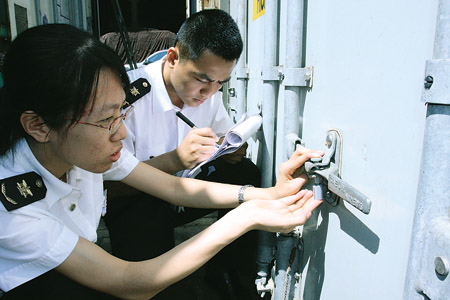Zhanjiang Port: China's gateway for food imports

The amount of imported food processed through Zhanjiang Port has risen from 520,000 tons in 2009 to 3.27 million tons in 2017, with the variety going up from what was mostly soybean to rapeseed, corn, sorghum, barley and tapioca.
In response to the surging imports, the Zhanjiang Entry-Exit Inspection and Quarantine Bureau has been improving itself by upgrading the infrastructure and testing out innovative technologies, while also motivating its personnel to hone their skills.

Two staff members of the Zhanjiang Entry-Exit Inspection and Quarantine Bureau inspect a container. [Photo/aqsiq.gov.cn]
Apart from 123 authorized projects, the bureau has had its laboratories certified by two extremely stringent national bodies, the China Inspection Body and Laboratory Mandatory Approval (CMA) and the China National Accreditation Service for Conformity Assessment (CNAS).
Furthermore, a large amount of capital was invested for checking and upgrading of equipment. This is to supplement the multiple training sessions that have been held to help staff members have a more thorough grasp of epidemic analysis and monitoring.
Zhanjiang Port started importing food to Southwest China in 1959 and today is recognized as a port of national importance. Under the guidance of the bureau, the port was among the first group of ports to be designated as one that could import goods for the nation by the General Administration of Quality Supervision, Inspection and Quarantine in 2013.
MOST POPULAR
Editors' Picks
 Infographic:
China's 5G subscriptions hit a new milestone
Infographic:
China's 5G subscriptions hit a new milestone
 Database:
China Economic Data Tracker
Database:
China Economic Data Tracker
 Infographic:
China extends visa-free transit to 240 hours
Infographic:
China extends visa-free transit to 240 hours




